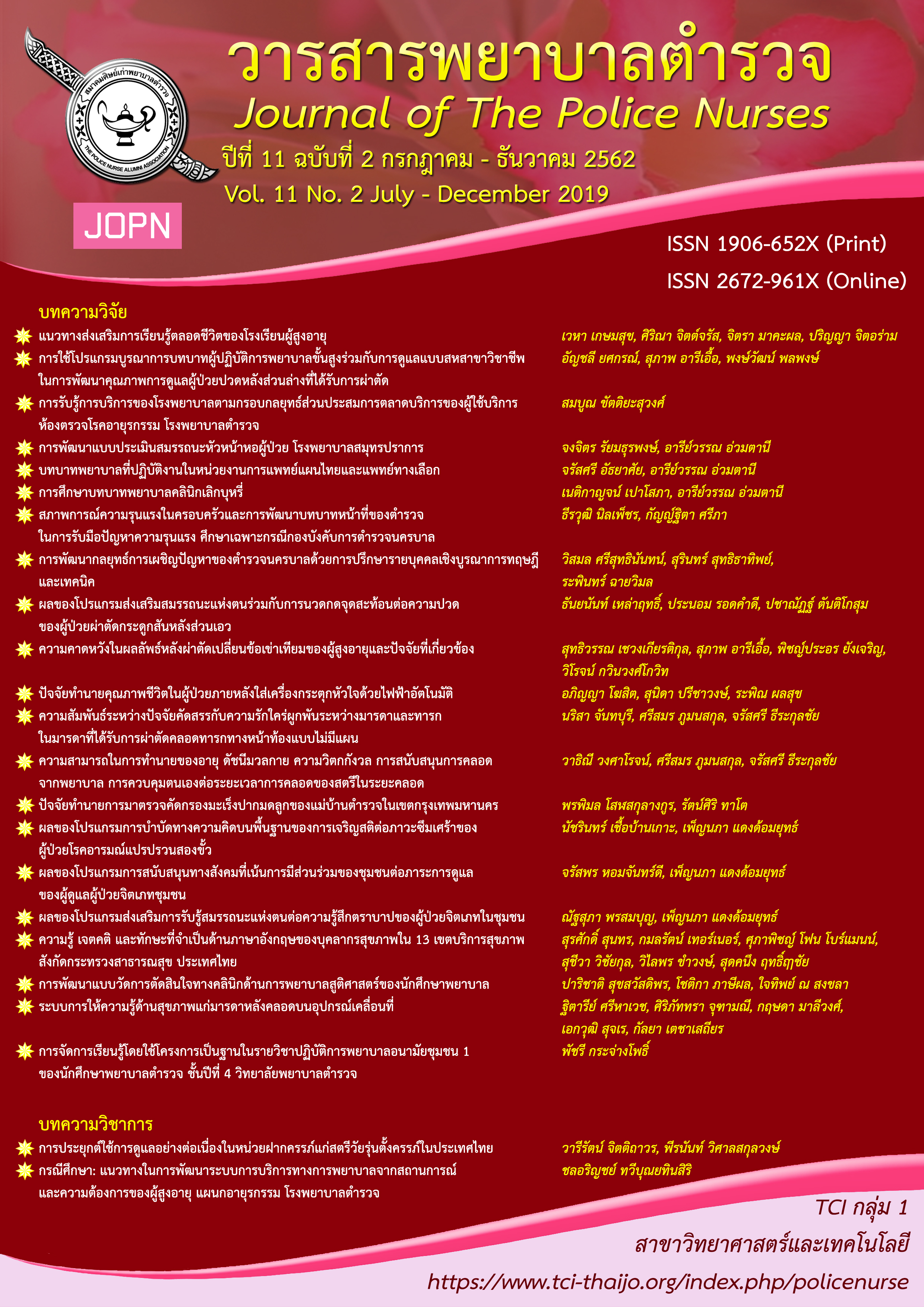NURSE’S ROLES IN A THAI TRADITIONAL MEDICINE AND ALTERNATIVE MEDICINE UNIT
Keywords:
nurses’ roles, Thai Traditional Medicine and Alternative Medicine unit, ethnographic delphi futures researchAbstract
The purpose of this descriptive research was to study the nurse’s roles in Thai Traditional medicine and Alternative Medicine (TTAM) unit by using EDFR technique. Informants were 17 experts. The EDFR technique was used under 3 major steps. Step 1: All experts were interviewed about the nurse’s roles in Thai traditional medicine and alternative medicine unit. Step 2: Interviewed data were analyzed to develop a questionnaire and the questionnaire was sent to prior experts for their opinions. Step 3: Questionnaire items were analyzed by using the mean and inter quartile range, then sent back to the experts for their confirmation.
The results can be summarized in the nurse’s roles in Thai Traditional medicine and Alternative Medicine unit composed of 5 categories as follows: 1) A care provider including patient care of Conventional medicine and TTAM by nursing process. 2) An informant and counselor in both Conventional medicine and TTAM services concerning in the informing process to the individual patient, family, etc. 3) A risk manager to assess the risk management from the Conventional medicine and TTAM regarding planning controls and risk management as a system. 4) A coordinator for Conventional medicine and TTAM services regarding coordination with the staff and relevant departments with patient care of the Conventional medicine and TTAM. And 5) A self-developer including improving knowledge and conducting nursing research integrated in Conventional medicine and TTAM. According to the findings, the nurse executives can use the research findings to prepare and develop the nurse who are working in Thai traditional and alternative medicine unit. In addition, nurses can use these findings to prepare themselves before working in this unit.
Downloads
References
Burns, N., & Grove, S. K. (2001). The practice of nursing research (4th ed). Philadelphia: W.B. Saunders.
Cornman, B. J., Carr, C. A., & Heitkemper, M. M. (2006). Integrating CAM into nursing curricula: CAM camp as an educational intervention. Explore, 2, 226–231.
Cooper, R., Henderson, T., & Dietrich, C. (1998). Roles of nonphysician clinicians as autonomous providers of patient care. Journal of the American Medical Association, 280(9), 795-801.
Cornman, B. J., Carr, C. A., & Heitkemper, M. M. (2006). Integrating CAM into nursing curricula: CAM camp as an educational intervention. Explore, 2(3), 226–231.
Department of Thai Traditional and Alternative medicine Institute of Thai Medicine. (2014). Thai traditional medicine & integrative medicine promoting hospital standard (TIPhS). The War Veterans Organization Officer of Printing Mill.
Fenton, M. V., & Morris, D. L. (2003). The integration of holistic nursing practices and complementary and alternative modalities into curricula of schools of nursing. Alternative Therapies in Health and Medicine, 9(4), 62–67.
Fowler, S., & Newton L. (2006). Complementary and alternative therapies: The nurse’s role. Journal of Neuroscience Nursing, 38(4), 261-264.
George, T. L. (1996). An account of nurses’ role using complementary therapies. Complementary Therapies in Nursing & Midwifery, 2(5), 130-133.
Haruthai, C. (2016). Conference in the topic of new generation in nursing going further with integrated medicine: The role of nurses with integrated medicine and alternative medicine. Between 27-29 July 2016 at Abina House Hotel, Bangkok.
Hatthakit, U., Parker, M., & Niyomthai, N. (2014). Nurses’ experience in integrating complementary therapies into nursing practice. Thai Journal of Nursing Research, 8(2), 126-143.
Hubble, M., & Middleton, M. (1995). A nurse’s role in complementary medicine. Complementary Therapies in Medicine, 3(3), 171-174.
Kreitzer, M. J., Mann, D., & Lumpkin, M. (2008). CAM competencies for the health professions. Complementary Health Practice Review, 13(1), 63–72.
Linstone, H. A., & Turoff, M. (1975). The delphi method: Technique & application. MA: Addison-Wesley.
Ministry of public health, Department of Thai traditional and alternative medicine. (2013). Thai Traditional and Alternative Health Profile, 2011-2013. Foundation of Thai traditional and alternative medicine.
Ministry of public health, Health administration division. (2016). Health service plan 2018–2022. The agricultural co-operative federation of Thailand., LTD.
Nursing Division, Ministry of public health. (2009). Roles and responsibilities of registered nurse who work in hospital. Thammasat printing house.
Phooma, S., & Aungsusing, K. (2016). Situation of Thai Traditional Medicine Service in District Health Promotion Hospital. Journal of Thai Traditional Medicine and Alternative Medicine, 14(1), 21-36.
Poonpattharachewin, J. (1986). Future research. Research Methodology.
Snyder, M., & Lindquist, R. (2010). Complementary and alternative therapies in nursing. New York, NY: Springer Publishing Company.
Williamson, A. T., Fletcher, P. C., & Dawson, K. A., (2003). Complementary and alternative medicine. Use in an older population. Journal of Gerontological Nursing, 29(5), 20-28.
Wolsko, P. M., Eisenberg, D. M., Davis, R. B., Ettner, S. L., & Phillips, R. S. (2002). Insurance coverage, medical conditions, and visits to alternative medicine providers: Results of a national survey. Internal Medicine, 162(3), 281–287.
World Health Organization (WHO). (2013). WHO traditional medicine strategy 2014-2023. Hong Kong SAR, China.
Downloads
Published
How to Cite
Issue
Section
License
ผลงานที่ได้ตีพิมพ์แล้วจะเป็นลิขสิทธิ์ของวารสารพยาบาลตำรวจ



